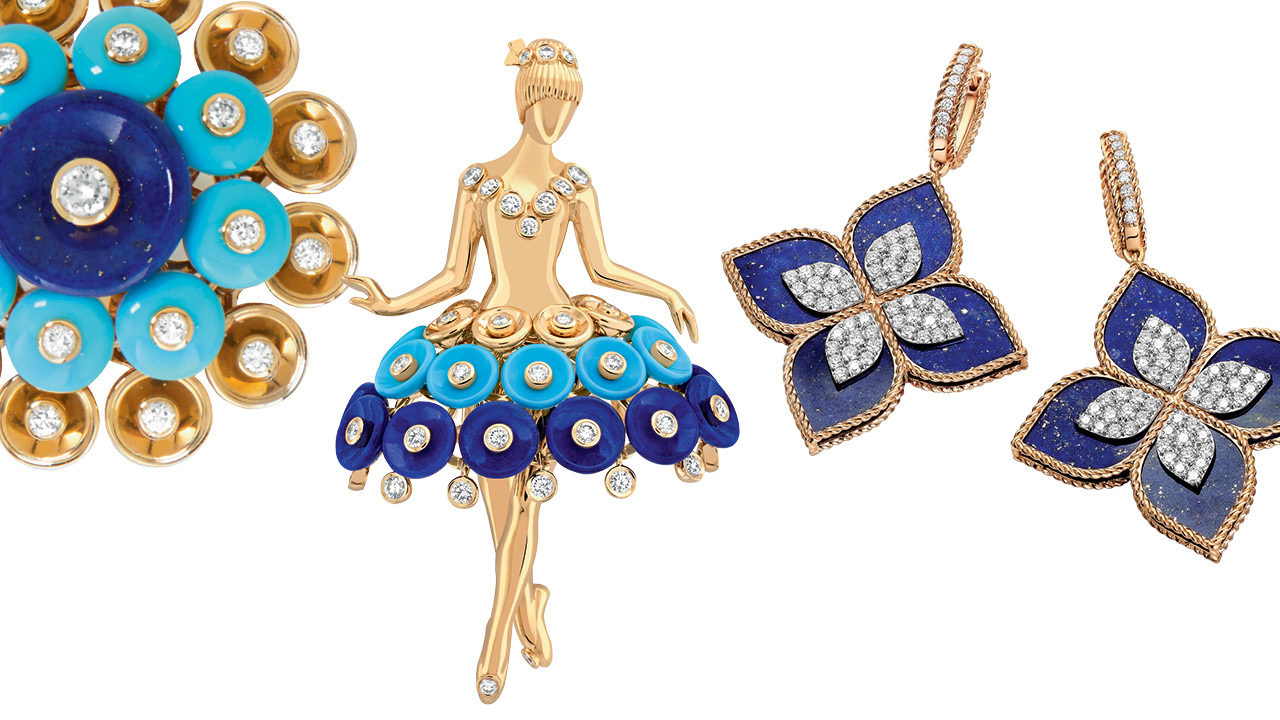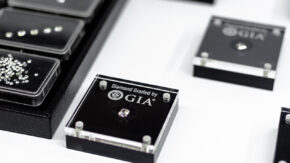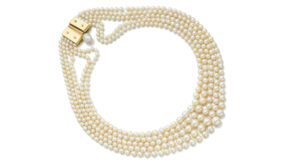This deep-blue stone has been gracing sculptures, mosaics, paintings and personal adornments for millennia.
The rich blue gem known as lapis lazuli has long evoked comparisons to a star-flecked evening sky. The similarity even helped inspire its name: The Latin “lapis” means “stone,” while “lazulum,” meaning “blue,” comes from the Arabic or Persian “lazward” for “sky.”
Lapis is not a single mineral, but a metamorphic rock consisting of multiple materials. The main component that gives the stone its distinctive color is lazurite, a tectosilicate mineral.
“Today, lapis is a beloved gemstone among lapidaries, jewelry artists and gem enthusiasts,” says Helen Serras-Herman, creative director of Gem Art Center near Tucson, Arizona, who often sculpts lapis for her designs. “It is a popular material for cabochons, beads, carvings, small sculptures, decorative items, inlays, and even pigments.”
The traditional source of the finest lapis specimens is the same today as it was thousands of years ago: the mountains of Afghanistan. However, there are also mining sites in Chile, Russia, Pakistan, Angola, Canada and the US.
Despite the geopolitical problems that have plagued Afghanistan, low- and medium-quality rough lapis from the country’s Sar-i Sang mines continues to arrive in Kabul and in Peshawar, Pakistan, reports Gary Bowersox. A leading expert on Afghanistan, Bowersox is the CEO of Hawaii-based wholesaler Gem Hunters Corporation, which offers Afghan lapis among its wares.
“The supply of high-quality lapis lazuli has diminished,” he says. “Prices in Kabul for lapis are currently down from previous years by approximately 70%, as shipments to other countries are not allowed. Prices in Peshawar are slightly lower than previous years, which is supported by the lower value of the Pakistani rupee versus the US dollar.”
Diverse makeup
The lazurite in this gem “is usually accompanied by white calcite veins, pyrite crystals, and smaller amounts of diopside, mica, hauynite and hornblende,” according to Serras-Herman. The perfect balance of these ingredients produces a “bright royal blue body color, sometimes with a violet tint, sprinkled with a small amount of pyrite crystals that add golden flecks, and some fine white lines of calcite — both of which create a more authentic and natural look.”
The stone’s value is determined almost exclusively by its color, says Daniele Bruni, creative director of Italian brand Pasquale Bruni, which uses lapis in its collections. “A deep, intense blue with violet tones is the most prized color,” he elaborates, adding that “fine-grained, uniform stones can obtain a smooth, highly polished surface not seen in lower grades.”
Lapis of all grades is opaque, but high-grade natural goods without any calcite or pyrite inclusions are rare, notes Serras-Herman. As such, the absence of such inclusions can raise suspicions about a stone’s natural origin, or at least indicate that it might have undergone some kind of treatment.
Tricks of treatment
The most common enhancement for lapis lazuli is to use a blue dye to make the white calcite less visible and improve the color. The stone then frequently gets sealed with wax, oil or resin, which can also enhance the luster of polished surfaces.
If a stone has been treated, it’s essential to disclose this to the customer, maintains Texas retailer Susan Eisen, owner of Susan Eisen Fine Jewelry. She also warns that if the surface is not sealed or the treatment hasn’t hardened, a colored dye may come off on clothes and cause real problems. “There is a lot of inferior product out there, and lapis is often confused with sodalite, which is not nearly so beautiful.”
Testing for authenticity takes place in gem labs such as New York-based American Gemological Laboratories (AGL). CEO Christopher Smith says the lab doesn’t see lapis that often, but the specimens it does receive are natural and of nicer quality.
“They may come from a manufacturer that wants to verify the authenticity of the stone, or a buyer who wants to confirm that it is natural,” he explains. While AGL doesn’t do lapis valuations, it does test the material for imitations, treatments, composite material, and the presence of other gems such as sodalite.
Magical by design
While lapis has a beauty of its own, “it’s through the creativity of designers that it can express its magic and esoteric side,” says Bruni.
Parisian designer Lydia Courteille declares herself “really in love with the blue color of lapis” and employs it in several of her original pieces, while Italian brand Roberto Coin features the gem in its Princess Flower collection, calling it “the stone of inner vision.”
Lapis is also popular in India, where jeweler Ankit Malpani has created several collections around it. “The deep blue color and sparkling inclusions give the gem its particular character,” Malpani says.
Eisen sells some lapis designs, including custom orders, although she “did not see a lot” at the Tucson gem shows this past February. She points to affordability as one of the gem’s assets. “It is not an expensive stone, and is popular in the southwest because it goes well with turquoise and is a very masculine color for men’s jewelry.”
Through the ages
Mining for lapis lazuli dates back to about 7000 BCE in northeastern Afghanistan, which was where the ancient Egyptian and Mesopotamian civilizations sourced the stone, according to antique jewelry specialist Ioannis Alexandris, CEO of Germany-based dealer Gemolithos. Archaeologists have found beads, jewels, scarabs and small sculptures made of lapis lazuli at sites in Afghanistan, Pakistan, Egypt and Iraq.
“One of the most famous examples of ancient lapis use is Tutankhamen’s mask [from circa 1323 BCE], which is inlaid with lapis, turquoise, carnelian, gold, obsidian, and glass paste,” adds Alexandris.
The earliest lapis jewels and carvings found in China contain stones from Afghanistan and date back to about 475 BCE. In the fourth century CE, the stone was used as a pigment for Buddhist wall paintings in the Mogao Caves near Dunhaung, along China’s Silk Road.
During the late Middle Ages, Europeans imported lapis and ground it into a powder to make ultramarine, the most expensive pigment available at the time — gold being second. Many Renaissance and Baroque artists used it until French chemist Jean-Baptiste Guimet developed a synthetic ultramarine in the late 1820s. Among the notable paintings containing the lapis pigment are The Wilton Diptych from the late 14th century, Masaccio’s Virgin Mary (circa 1426), Titian’s Bacchus and Ariadne (circa 1520 to 1523), and Johannes Vermeer’s Girl with a Pearl Earring (circa 1665). Some later artists continued to use the natural ultramarine, including Vincent Van Gogh in The Starry Night (1889).
Two lapis lazuli columns feature in Saint Isaac’s Cathedral in Saint Petersburg, Russia, which was built in the 19th century. Russia was — and still is — a significant source of the mineral, with deposits in Siberia’s Lake Baikal area. Beyond architecture, one of the most impressive Russian works is the lapis lazuli egg that Carl Fabergé created in the late 1880s, probably as a private commission.
In China, during the Qing dynasty, people associated lapis with heaven. It also represented royal court status. The gem has maintained its popularity through the 20th and 21st centuries, appearing not only in jewelry but also in watches, clocks, sculptures and other decorative items.
Images from left: Bouton d’or Ballerina clip in 18-karat yellow gold with lapis lazuli, turquoise and diamonds (Van Cleef & Arpels); Princess Flower earrings in 18-karat gold with lapis lazuli and diamonds (Roberto Coin)



